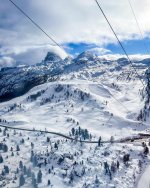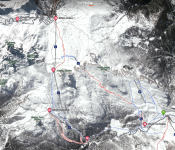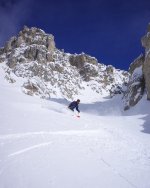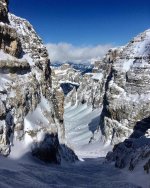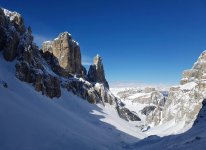ChrisC
Well-known member
After many below-average seasons, I decided Easter was the time to finally ski Italy after continuous mid-February-to-March snowfall. Initially, I was focused on Monterosa since they had received extreme snow—Champoluc was cut off by an avalanche in March.
However, I diverted at the last minute since the Easter storm was going to be too intense—30-60" of expected snow, but worse warm air—a possible rain line at 2000m+. The Monterosa website already hinted that the Alagna might be closed some days—the prime off-piste zone. This was the perfect mix for high avalanche potential and limited off-piste opportunities. So, I switched to the Dolomites (another bucket list destination) at the last minute. The weather forecast was for snow - lower amounts but still significant (20") and lower snow line 1000-1500m.
I was feeling good about my decision after reading the following post by Alta Badia-based (Corvara) ski guide, Francesco Tremolada (who wrote the book on 'Freeriding in the Dolomites'):
I decided to start the trip in stormy weather in Cortina and then later move to Arabba to ski the expert off-piste terrain (mostly couloirs/canales) under clear weather. Also, I knew this had to be a shorter trip - I always wanted to spend an entire week - so I would just try to hit the highlights and decide whether to return later.
I arrived late afternoon Saturday in Cortina to a mix of snow and rain. The town has charming village streets lined with quaint shops, cozy cafes, and elegant boutiques—full of Italians on Easter vacation. It is definitely a unique ski town and a classic on par with Chamonix, Zermatt, St. Moritz, Grindelwald, etc. However, due to the weather, one could not see its dramatic landscape, characterized by towering peaks, rugged cliffs, and picturesque valleys. And like most European ski towns this year, there was not much snow in town due to the lower 1200m elevation - despite a ton at altitude.
Skiing-wise, Cortina comprises 3 large areas: Tofana, Faloria/Cristallo, and Cinque Torri/Lagazuoi, and quite a few smaller ones:

Unfortunately, the following day, I woke up to heavy rain in town and revised weather forecasts of a possible snowline at 1800m. Initially, I expected to ski Cortina's most extensive area, Tofana; however, that needed to be revised since much of the area is below 1800m - or treeless higher runs - Ra Valles.
Therefore, I decided to ski Faloria/Cristallo since the cable car starts in town, and most slopes have trees and/or above 1700m:

It was a good call, and it was heavily snowing when I arrived at the cable car top station at Faloria (2100m). I started to lap the Vitelli lift #54 that reached the Tondi summit (2300+m) and served a steep semi-open bowl. The terrain was low-expert, and the pistes could be combined with the next lift, #56, for decent vertical runs - all covered with 12" of new snow. All precipitation remained snow above the ski area low point of Rio Gere 1680m. Overall, it was perfect storm-day terrain since rocks or trees provided perspective. Also, it was my own private ski area (I could lay my tracks down side-by-side from each run) since Cortina/Italian skiers stayed inside. Maybe there were 50 skiers on the hill? Things stayed fresh all day, about 8-16 inches new.
One interesting piste was #62 - used in a past Olympics and likely for the upcoming Winter Games here in 2026:
A better view of north-facing Faloria:

The opposite side of the mountain, Cristallo, was a little less interesting. It mainly had pisted runs with little ability to go off-piste. However, it had a tremendous on-mountain eatery—Rifugio Son Forca. It is a fantastic lunch—venison accompanied by a mouth-watering raspberry sauce. To finish, a delicious homemade tiramisu.

A better view of Cristallo:

Unfortunately, my usable photos for the day are about Zero since it was too snowy with low clouds. No beautiful views of Cortina and the Dolomites. A lull in the storm at Rifugio Faloria showing the upper bowl/Tondi summit/Vitelli lift:

One interesting note: The summit of Cristallo has been inaccessible since 2016, preventing access to a steep-walled couloir and supposedly amazing off-piste on the north-facing backside. There are proposals to replace the lift - maybe by the Olympics? Reference photo: The lift has been missing for 8 years

Overall, it was an excellent first day with stormy skiing snow. Snow was a little heavy down low.
One famous Off-piste itinerary I missed was Sci 18. However, I was not going to attempt route navigation and obvious avalanche potential.

To be continued
However, I diverted at the last minute since the Easter storm was going to be too intense—30-60" of expected snow, but worse warm air—a possible rain line at 2000m+. The Monterosa website already hinted that the Alagna might be closed some days—the prime off-piste zone. This was the perfect mix for high avalanche potential and limited off-piste opportunities. So, I switched to the Dolomites (another bucket list destination) at the last minute. The weather forecast was for snow - lower amounts but still significant (20") and lower snow line 1000-1500m.
I was feeling good about my decision after reading the following post by Alta Badia-based (Corvara) ski guide, Francesco Tremolada (who wrote the book on 'Freeriding in the Dolomites'):
At the end of February, we had a long period of bad weather that finally brought some snow to the Dolomites. Conditions improved markedly, thanks to a nice base, especially at altitude. The month of March was then a succession of beautiful days, often with typically spring-like temperatures, and more bad weather and snow. In general, it was the best period ever for ski mountaineering and freeriding, also in relation to the past two seasons. This end of season, if the weather turns good again, could offer some super days of skiing and great steep descents. We’ll see. In the meantime, here are some photos of the last few days in the Dolomites.
The Dolomites/Dolomiti Superski is a vast ski region - some sections linked, some easily connected by an excellent bus system. If everything is combined and counted as one, it's larger than The 3 Vallees or Portes du Soliel - making it the largest ski area in the world. It has significant upsides (extent, scenery, endless cruising, snowmaking, food/wine, endless number of refugios, lower prices than most major resorts, history) and also downsides (erratic snow, weird off-piste policies, lack of on-piste expert terrain).I decided to start the trip in stormy weather in Cortina and then later move to Arabba to ski the expert off-piste terrain (mostly couloirs/canales) under clear weather. Also, I knew this had to be a shorter trip - I always wanted to spend an entire week - so I would just try to hit the highlights and decide whether to return later.
I arrived late afternoon Saturday in Cortina to a mix of snow and rain. The town has charming village streets lined with quaint shops, cozy cafes, and elegant boutiques—full of Italians on Easter vacation. It is definitely a unique ski town and a classic on par with Chamonix, Zermatt, St. Moritz, Grindelwald, etc. However, due to the weather, one could not see its dramatic landscape, characterized by towering peaks, rugged cliffs, and picturesque valleys. And like most European ski towns this year, there was not much snow in town due to the lower 1200m elevation - despite a ton at altitude.
Skiing-wise, Cortina comprises 3 large areas: Tofana, Faloria/Cristallo, and Cinque Torri/Lagazuoi, and quite a few smaller ones:
Unfortunately, the following day, I woke up to heavy rain in town and revised weather forecasts of a possible snowline at 1800m. Initially, I expected to ski Cortina's most extensive area, Tofana; however, that needed to be revised since much of the area is below 1800m - or treeless higher runs - Ra Valles.
Therefore, I decided to ski Faloria/Cristallo since the cable car starts in town, and most slopes have trees and/or above 1700m:
It was a good call, and it was heavily snowing when I arrived at the cable car top station at Faloria (2100m). I started to lap the Vitelli lift #54 that reached the Tondi summit (2300+m) and served a steep semi-open bowl. The terrain was low-expert, and the pistes could be combined with the next lift, #56, for decent vertical runs - all covered with 12" of new snow. All precipitation remained snow above the ski area low point of Rio Gere 1680m. Overall, it was perfect storm-day terrain since rocks or trees provided perspective. Also, it was my own private ski area (I could lay my tracks down side-by-side from each run) since Cortina/Italian skiers stayed inside. Maybe there were 50 skiers on the hill? Things stayed fresh all day, about 8-16 inches new.
One interesting piste was #62 - used in a past Olympics and likely for the upcoming Winter Games here in 2026:
"This black ski slope became famous during the 1956 Winter Olympics with the victory of the Giant Slalom gold medal by Toni Sailer. It is a continuous succession of steep and flat sections, and the final part is very panoramic, with Mount Cristallo right in front of the skiers in all its majesty.
The track is relatively narrow and quite steep, with a maximum slope grade of 51% and a total length of 1,169 meters, perfect for advanced skiers."
A better view of north-facing Faloria:
The opposite side of the mountain, Cristallo, was a little less interesting. It mainly had pisted runs with little ability to go off-piste. However, it had a tremendous on-mountain eatery—Rifugio Son Forca. It is a fantastic lunch—venison accompanied by a mouth-watering raspberry sauce. To finish, a delicious homemade tiramisu.
A better view of Cristallo:
Unfortunately, my usable photos for the day are about Zero since it was too snowy with low clouds. No beautiful views of Cortina and the Dolomites. A lull in the storm at Rifugio Faloria showing the upper bowl/Tondi summit/Vitelli lift:
One interesting note: The summit of Cristallo has been inaccessible since 2016, preventing access to a steep-walled couloir and supposedly amazing off-piste on the north-facing backside. There are proposals to replace the lift - maybe by the Olympics? Reference photo: The lift has been missing for 8 years
Overall, it was an excellent first day with stormy skiing snow. Snow was a little heavy down low.
One famous Off-piste itinerary I missed was Sci 18. However, I was not going to attempt route navigation and obvious avalanche potential.
The tour starts from the top station of the Faloria cable car, from where you have to ski down along the slope slightly towards the left; you will reach an old construction, used in 1993 to film “Cliffhanger” with Sylvester Stallone. The initial part is a bit narrow; however, as you ski down the slope you will reach a larger plateau, which reveals many glimpses of the Ampezzo valley. There are many different couloirs used to approach this freeride, but the conditions of the snow cover are always to be evaluated. Once you have reached the wood, go right for the last steep section of the descent among the larches and you will arrive at the middle station of the cable car, which you can take to go up again and repeat the descent. If you continue past the middle station, you can reach the base station. Another possibility is to continue left on a beautiful slope and arrive near Baita Fraina (where you can leave a second car or make it back by taxi).Once considered a challenging freeride, nowadays it is a very popular tour, due to the possibility to go up rapidly by cable car.
To be continued
Last edited:
